Compact - Mini Excavator
A micro or mini excavator is a tracked or wheeled vehicle with an operational weight range of 0.7 to 8.5 tonnes. It frequently incorporates a normal backfill blade in addition to an independent boom swing.
Hydraulic excavators differ significantly from conventional construction equipment in this way because hydraulic fluid is carried throughout the entire machine throughout all movements and operations. The work group and blade on the mini excavator are activated by hydraulic fluid flowing across hydraulic cylinders. Additionally, hydraulic motors that are fuelled by hydraulic fluid power the excavator's slew (rotation) and travel movements.
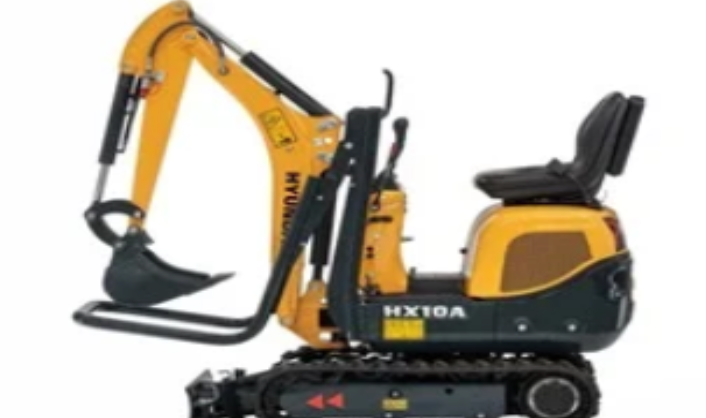
What Sizes Do Micro And Mini Diggers Come In?
Micro and mini diggers come in a wide range of sizes; we've listed the most popular sizes below, along with a description and some of their primary functions.
0.8 Tonne Micro Digger - Excavator
General Information
These gadgets are ideal for use in backyards or other places with limited access because they fit easily through a standard 760mm fence or doorway. Accessible in low-lying areas because to the roll bar's adjustable height, the expanding track system increases stability while it's in use. Because of its simple controls, this machine can be used for a range of landscaping activities as well as other little jobs.
Features
Adjustable track gauge
1 lever operation
A boom cylinder situated on top of the boom offers the best protection for the front end hydraulic piping, which is run inside of it.
Folding ROPS are portable and may fit through doors.
Superior results
When there is a need for a lot of work and there is limited space, it is incredibly compact and reliable.
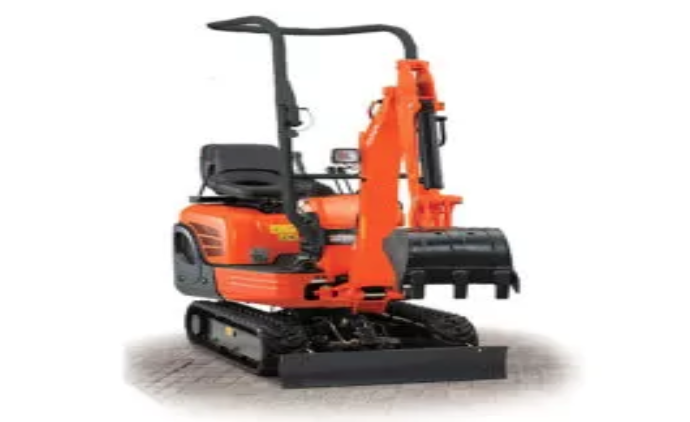
1 Tonne Mini Excavator - Digger
Information
One-ton excavators are strong, adaptable, and long-lasting. Trench digging, hole-breaking, waste collection, and mine excavation are all excellent uses for these excavators. The 1-ton digger can fit into even the smallest places because to its compact and stylish design. Its comfort and silence make it safe to use even in areas with a lot of people.
Features
with a back overhang of four to twelve inches
an undercarriage that retracts between 28 and 29.5 inches
The maximum digging depth is 6 feet, while the maximum digging height is 7 feet, 8 inches.
Mechanical handler with EPA Tier 5 and emission standard compliance, a straightforward design, and a high-precision pilot joystick.
an extremely flexible side-to-side swing boom
a ROPS bar for the protection of the operator

1.5 Tonne Mini Excavator - Digger
Information
The most popular size for compact situations is the 1.5 tonne micro excavator, provided access is not a problem. The digger expands its tracks to improve stability while excavating and tracking. This machine cannot accept an auger attachment, but it can accept a breaker attachment, hence we do not recommend using it as a crane (breaker price is additional).
Features
105cm wide
23.6cm in height
With fuel and buckets, the weight is 1.8 tonnes.
Drilling depth of 23.9 cm
length 4035mm
Maximum dump height: 2705mm
Tyre tracks
Widening track spacing
a glass cab
extensions plus a bulldozer blade
Boom swinging off-set
various bucket sizes
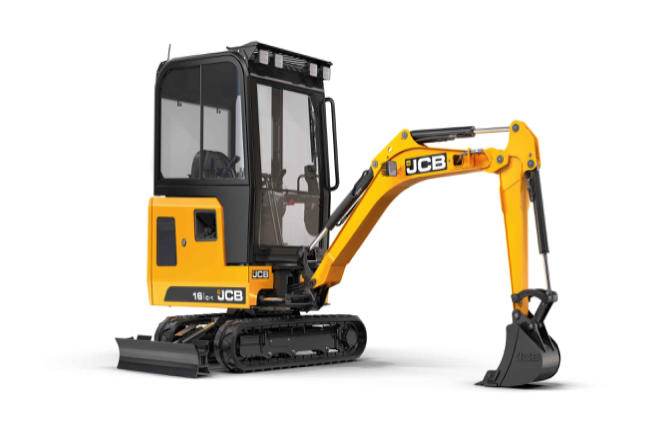
2 Tonne Mini Excavator - Digger
Description
The 2 tonne diggers' fully enclosed cab and additional feature of hydraulically moveable tracks for improved support and agility allow them to be used in the majority of conditions. In turn, this makes the digger 100mm thinner than a 1.5 tonne digger with the tracks closed.
Features
The 2 tonne digger has several advantages over the 1.6. (based around longer reach and stability)
significantly wider blade (extension removed for narrow access)
The track frame is longer.
a dozer's blade should be longer.
larger weight
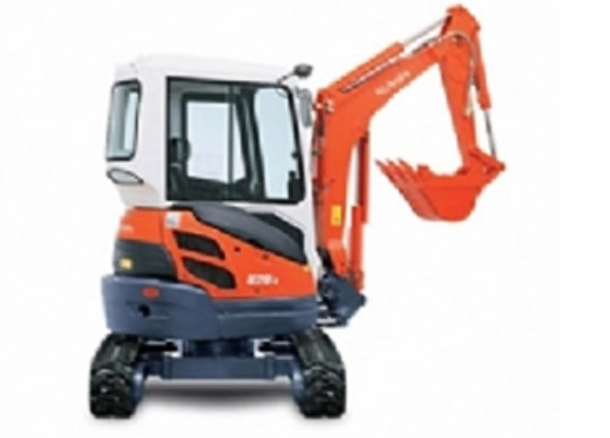
3 Tonne Mini Excavator - Digger
Description
This 3-ton compact digger offers the widest digging depth and reach of any excavator in its weight class. It has a long reach and a powerful digging motion, but it can only be adjusted to a breadth of 1.5 metres.
The 3 tonne compact digger excels where other small diggers in its class fail by providing operator comfort, despite its ability to narrow down to just 1.5m wide. It also has a spacious cabin and is incredibly stable on uneven ground. It also provides a lot of lift force when required.
Features
The tracks provide excellent performance and stability and may be adjusted up to 1500mm.
4 cylinder diesel engine with a 27.5 PS power rating.
The greatest depth of this type of compact excavator is roughly three metres (2870mm).
strong digging and lifting skills.
For the operator's safety and comfort, a strong and roomy cabin is provided.
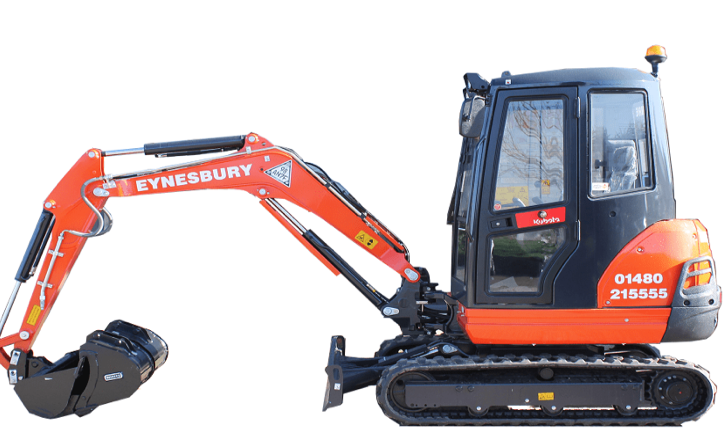
Excavator Parts & Attachments
Excavators can be modified by changing out the attachments to meet the demands of a specific job. Typical hydraulic attachments include things like buckets, augers, breakers, thumbs, and couplers.
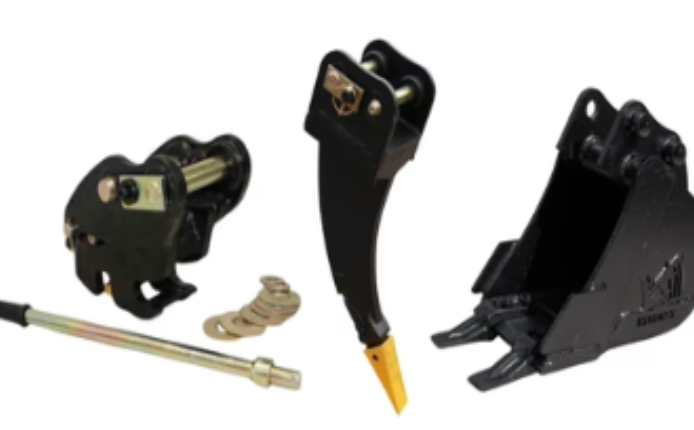
Excavator Bucket
A bucket is the most widely used excavator attachment. Because of its steel composition and teeth-like edges, they are ideal for scooping and excavating. The most common buckets are those for grading and ditching stones (also known as "ditching buckets") (the trenching bucket). When selecting the type of bucket to buy or rent, it's important to take the quality of the soil and any potential attachments, like couplers, into account.
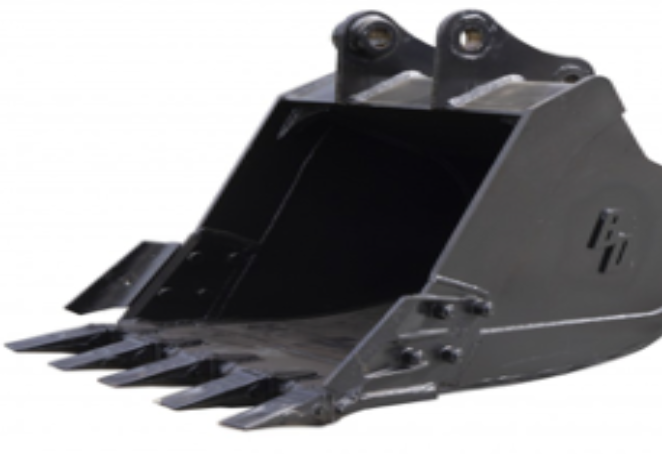
Mini Excavator Auger
An auger is a device used to drill into the earth. They are hydraulically propelled, so they can dig deep holes quickly and efficiently. Augers come in sizes from 4 inches to 50 inches, and they can dig up to 32 feet.

Mini Excavator Breaker
Concrete, stone, and other tough materials are easily broken through by breakers, which resemble a larger jackhammer.
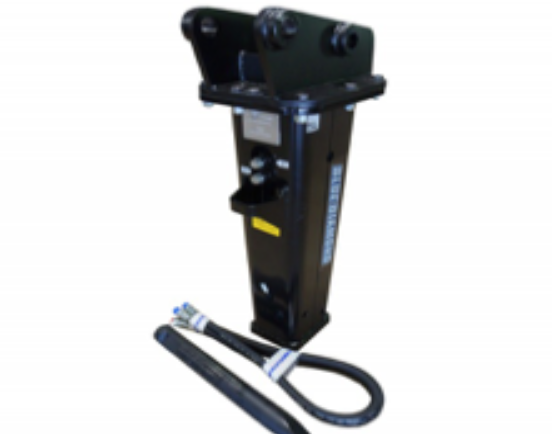
Mini Excavator Thumb
Thumbs work well for items that are too large for a bucket, such as a tree trunk or concrete slab. They are easy to put on and take off.
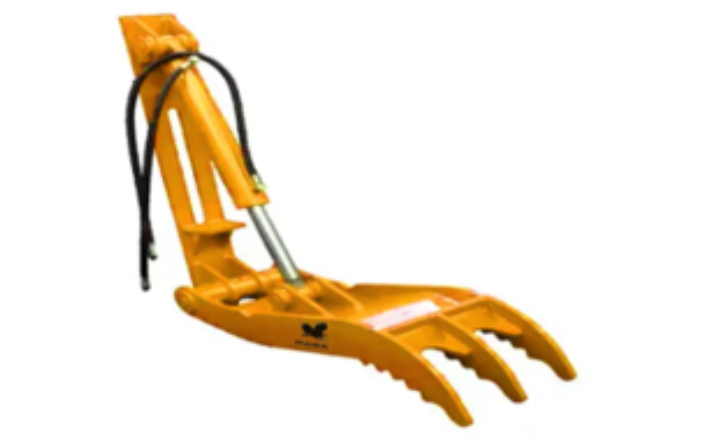
Mini Excavator Couplers
Couplers make the exchange of attachments easier and faster. If your line of work requires regular attachment modifications, an attachment coupler can help you save time, money, and resources like manpower.
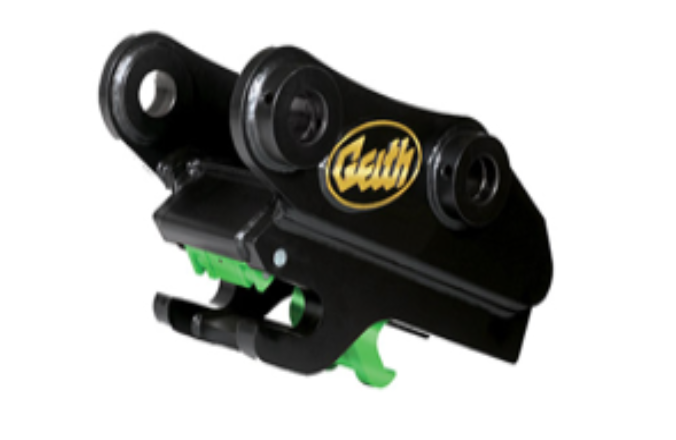
How to Use a Mini-Excavator
Nowadays, everyone is looking for ways to do tasks more quickly. Homeowners and contractors may find comfort in little excavators. These tools may be used for practically any type of construction task, from hammering concrete to digging holes for landscaping, thanks to their great adaptability. These versatile, user-friendly tools are crucial tools for development, particularly in urban settings where space limitations call for smaller, lighter equipment.
What can A Mini Digger Do?
Add a hydraulic hammer for demolition and pipe digging chores.
Create a curb or walkway at a busy crossroads without impeding traffic.
Attach a thumb and an earth auger to load brush and sort recyclables.
Use for a range of outside projects, like digging sewage or electrical conduit.
Concrete should be broken up with a hammer attachment for demolition and recycling.
Dig holes for landscaping work using 12- to 24-inch buckets.
With as little interruption to neighbouring businesses as possible, finish the interior of the strip mall, install the plumbing, and remove the concrete.
Due to their low buoyancy, older structures are easily disassembled and reconstructed on many levels, allowing for advancements.
Occasionally, the two pieces of equipment could be less expensive than a bigger backhoe when employed with a skid-steer. Additionally, they are able to oversee two projects at once.
Numerous types of buckets can be used to gather various types of digging and soil. Use a 24-inch bucket, for instance, for digging footings. Use a 12- or 18-inch bucket to dig up utility lines. Use a 36-inch drainage bucket to remove water and loose dirt from moist soil.
What Advantages Are There To Using A Mini Digger?
Micro excavators seem huge despite their small size. Operators of large excavators who loathe bouncing backhoes would love these gadgets. Mini excavators have several advantages for both professionals and homeowners. These tools:
Enter small, cramped areas; some fit via yard gates.
They are made to work similarly to larger excavators, so almost anyone can get onboard and pick it up in a matter of minutes.
To make changing any attachment that is mounted on a dipper easy, include a quick-coupler connection.
When moving over concrete and other hard surfaces, they are much quieter than huge gear.
Controls should be supplied that are simple to use.
They have nimble rubber wheels that are lightweight and simple to manoeuvre across narrow spaces without damaging the ground.
They are tiny enough to fit on pull-behind trailers and can be moved using the pickup truck's power. Some can even fit in an enlarged pickup bed.
Make use of a variety of accessories.
have a 360-degree swing arc to enable the placement of additional units, such as a dump truck, wherever they are required. The load can then be positioned where it is needed by turning the excavator. Typically, the dump's height is not a limiting constraint.
Avoid using steel rails since they will abrasively scratch the earth.
have rubber treads that won't cause slipping so you can carry the machine after you've loaded it.
Companies can decrease their paperwork because they don't need specific highway carrying permits or business driver's licences.
Using A Mini Excavator
Read the mini digger's instruction manual and any warning labels that may be attached to it. Next, look inside the device for any damaged or missing components. Watch out for any potential hazards, including as leaks, frayed cables, track problems, or other difficulties.
Make sure there is enough fuel in the plant to finish the job. Remember that using red and white diesel is subject to new rules (rebate fuel). Ensure that the load on your excavator complies with the laws in effect. Only a few businesses, including farming, horticulture, and agriculture, as well as government projects like gritting icy roads, are allowed to use fuel that has been rebated. Sadly, DIY and construction are of poor quality. Once the fire extinguisher has been located, check the coolant and oil levels in the engine. Ascend to the command console at this time.
Controls and an armrest are located on the left side of the miniature excavator. Normally, it is raised and shifted out of the way of the door. Pulling the armrest downward locks it into position. Next, check the driver's console, then firmly fasten your seatbelt. Locate all of the available gauges and controls, as well as the ignition switch. Normally, the ignition switch is found either above or to the right.
The excavator's cab is filled with pedals, levers, and joysticks. The joysticks control the rotation of the boom, bucket, and left and right cabs. Levers are used to regulate the front blade, throttle, and driving tracks. The pedals regulate the bucket's pivoting and high-speed mode (if applicable). While the digger is running, experiment with each control to see how it reacts. Any control movement has an immediate effect on the machine. Therefore, it is advisable to get acquainted with their movements before starting work.
Understand the device's fundamentals.
Inspect the controls
Check the gasoline level, for example.
Learn how to use the console's controls.
Is It Simple To Operate A Mini Excavator?
Mini diggers are actually rather simple to operate once you become familiar to the controls and the machine's movements. They have flexibility and range.
The amount of features, size, and complexity of the product all affect how easy or challenging it is to use. The front shovel, boom, and swinging bucket are the basic attachments for mini and micro diggers, providing the user with sturdy equipment in a small package. Larger excavators demand skilled heavy equipment operators and are more challenging to operate.
Why Use A smaller Mini Excavator?
Mini diggers are small and practical for a range of commercial and DIY tasks. Just a few benefits that make equipment so enticing are listed below:
There are several sizes and varieties of mini diggers to choose from. Choose the best option based on how you want to utilise it and the size of the project. Consider the space that can be utilised on the job site for securely storing the little digger.
They are used by businesses that manage numerous sites due to their modest size. They are essentially transported on trailers from one place to another. The tiny excavator, which is the perfect size for DIY projects, is readily available for home owners to borrow.
Since there are fewer regions, there is less pollution. The smaller tracks and other attachable equipment are less likely to damage topsoil and other outdoor surfaces.
What Are a Few Applications of a Mini-Digger?
Due of its compact size, the mini digger can be utilised for any project. Use these to choose which Mini excavator is ideal for the task at hand.
Smaller excavators are perfect for excavating holes since they are portable and easy to manoeuvre in small locations. When they are rented out, they typically come with a number of accessories and the instruction manuals. This information will enable you to select the ideal attachment for the projected excavation or hole.
When planting trees and plants in your garden, micro diggers are fantastic for digging. When properly prepared, they are ideal for installing ground irrigation on a site. Due to their little weight, they seldom ever cause soil or plants to be disturbed. When introducing new garden features like swimming pools, ponds, and hot tubs, they are crucial. The little digger can level the ground for the project and transfer heavy machinery.
Mini diggers are perfect for demolishing small, dilapidated yard structures like sheds or fences.
What Controls Does a Mini-Digger Have?
With the right hand, lower the primary boom.
Main boom up, right hand back.
Right hand behind, main boom raised.
Curl the bucket out with your right hand (dump)
Lean left and swing your left hand.
Swing to the right using your left hand.
Step forward and stick boom (dipper) away with your left hand.
With the left hand, stick the boom (dipper) close from behind.
The most frequent control setup for an excavator is the ISO pattern. In America, the SAE controls are the most used pattern. Since the controls for the stick boom and main boom are located in different locations, they are comparable but different. For instance, by sliding the left joystick forward and backward, the primary boom can be lifted and lowered.
Does A License Need To Be Obtained To Operate Mini Or Micro Excavators Or Diggers?
Any private property, job site, or access road may be used by an unlicensed driver to operate a mini-digger. Therefore, you can excavate on your own property without obtaining the necessary permits. All you need to operate any size of digger on a public road is a current driver's licence.
You must be qualified to work in public areas or on the side of the road. You can operate any size rotating-base digging machine in any of these places as a 360 excavator operator.
You must enrol in lessons at a training centre and obtain a current Construction Plant Competence Scheme (CPCS) card in order to operate a 360 excavator. To work on a construction site, you also need a Construction Skills Certification Scheme (CSCS) card.
Tips For Safe Mini Digger Operation
If the digger doesn't have a cab, make sure the detachable roll cage is securely fixed before using it. If the piece of equipment topples over, a cage can protect humans from serious risk.
Only flat, level terrain with the wheels or tracks parallel to the ground should be used for driving. To dig a flat trench, stability is needed.
Avoid swinging the bucket over somebody, even if it's empty, especially if they're within a piece of plant machinery or a portable toilet. Anything can happen, so there's no need to ever put anyone else in danger.
Use caution when moving the arm close to the cab to avoid running the bucket into the rails, wheels, or front blade. owing to the resilience of the pneumatic system and the risk of expensive bucket breaking.
When digging, make an effort to keep the track or wheels away from the edge of the trench. They may be more brittle and prone to crumbling here, especially if the soil and ground are soft.
Can A Small Excavator Or Digger Be Rented?
Many companies hire out various models of small (or compact) excavators. On the job site, mini excavators can be used for a range of activities, and renting equipment is far less expensive than purchasing it.
For equipment to be cost-effective, it must be used on site for at least 70% of the time. The cost of maintenance, inspection, and insurance must also be paid for by the owner, and equipment loses value with time. When using equipment you've hired from a reputable company, you only need to consider rental and fuel expenditures.
Do You Need A License To Operate A Mini Excavator?
An excavator of any size must be driven on a public road with a current driver's licence. However, a licence is not necessary for private job sites or access roads. Excavator operators no longer need to be qualified thanks to the 2011 Work Health & Safety Act.
Excavator operators need to be professional and skilled, as well as educated about all relevant guidelines and information. Legally, the Person Conducting a Business or Undertaking is ultimately responsible for operator competency (PCBU). They must be told about authorised users and how well-versed they are in correct usage, limitations, safety, and maintenance.
Are LOLER Inspections Required for Mini Diggers?
On construction projects, excavators are typically utilised for both lifting and excavation. Regular Lifting Operations and Lifting Equipment Regulations (LOLER) checks should be performed on all lifting equipment.
These inspections must be carried out by a "competent person" with knowledge in inspecting lifting equipment, and their results must be documented in a written report. Hire companies are deemed providers under Section 6 of the Health and Safety at Work Act and are in responsibility of providing secure equipment.
This necessitates extensive inspections, pre-use testing of equipment, and routine inspections. For extremely long hire periods, it is possible to draught a written agreement to transfer this to the hiring party. The user is often the only one responsible for doing initial and daily safety evaluations.
How Deep Can A Mini Excavator Dig Into The Earth?
The size of the model being used is a problem, of course. The reach required can vary depending on the specific project, however it is better to plan on going a little deeper than necessary as the Takeuchi TB260 6 tonne can dig down to a depth of 3.895 metres as opposed to the limited 1.755 metres of the Takeuchi TB210R. This takes into account any work-related difficulties that call for greater depth without the usage of additional tools. When selecting an excavator, the type of ground should be taken into consideration.
For instance, if work is to take place on soft ground, deeper footings will be needed. In hard, clay-rich soil, a greater digging effort and bucket reach are needed. When excavating near underground pipes and utility wires, caution must be taken to avoid damage (such as broadband cables and electrical supplies). Due to their relatively shallow digging depths and smaller bucket widths, mini excavators are ideal in this situation for performing initial and daily safety checks.
How Much Weight Can A Mini Digger Lift?
Excavators are widely employed for lifting and eliminating obstacles, despite their nickname as "diggers." Garbage needs to be moved or pushed out of the way, even when excavating. Concrete, hardcore, or other materials will make the trash in the bucket far heavier than it would be with dirt or other comparable materials. It is advisable to assess the lifting capability before to hiring because, like digging depth, it increases with excavator size.
An excavator's hydraulic and tipping capacities determine its lifting capacity. The maximum load that a machine can lift before stalling depends on its hydraulic capacity. An excavator's tipping capacity is the weight of the load that it can lift and possibly tumble.
Lift charts based on factory testing can be found in the Operation and Maintenance manual and are prominently displayed on the machine. Because it is in the cab or canopy, the operator can usually see it. It is important to realise that lift capacities must be reduced when utilised on hills or other uneven terrain because they are calculated for use on level, even surfaces.
The excavator's lifting capability should be listed in the specs on the rental company's website. If you're unsure, ask the company if you have the necessary tools. Lifting must be done carefully because any mishap could have detrimental effects on the operator and nearby workers.
How Heavy Is A Mini Excavator?
While micro excavators are often thought of as equipment that weighs less than 7 tonnes, tiny diggers can weigh as little as one tonne.
The fact that they are composed of lightweight materials means that they may be used without endangering delicate or sensitive surfaces, which is one of their main advantages. The majority of variants also come with rubber tracks that expand to help distribute the weight of the equipment. They are ideal for interior work or on finished surfaces.
Because of their heavier weight and metal rails, larger versions are more likely to damage the edges of flooring or concrete. Due of their modest weight, mini excavators are easily transported by truck or trailer.
Manufacturers Of Mini Diggers We Provide
Mini excavators from JCB, Bobcat, Kubota, and Caterpillar are available from us.
Bobcat Mini Diggers We Supply
Robs Digger Hire Oxfordshire Copyright© 2022 All Rights Reserved